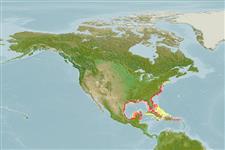Teleostei (teleosts) >
Eupercaria/misc (Various families in series Eupercaria) >
Sparidae (Porgies)
Etymology: Lagodon: Greek, lagos = hare + Greek, odous = teeth (Ref. 45335).
More on author: Linnaeus.
Environment: milieu / climate zone / depth range / distribution range
Ecology
Marine; freshwater; brackish; demersal; depth range 6 - 30 m (Ref. 44885). Subtropical; 42°N - 18°N, 98°W - 64°W
Western Atlantic: Massachusetts (USA), Bermuda, and northern Gulf of Mexico to Florida Keys, USA and Yucatan, Mexico. Also in northern coast of Cuba; absent in Bahamas or rest of Antilles (Ref. 26938).
Length at first maturity / Size / Weight / Age
Maturity: Lm 13.1, range 9 - 17.3 cm
Max length : 40.0 cm TL male/unsexed; (Ref. 3815); common length : 18.0 cm TL male/unsexed; (Ref. 3815); max. published weight: 1.5 kg (Ref. 40637)
Commonly found on vegetated bottoms, occasionally over rocky bottoms and in mangrove areas. Enters brackish water and even freshwaters. Often forms large aggregations. Feeds mainly on small animals, especially crustaceans, but also takes mollusks, worms and occasionally small fishes that are associated with the grassy habitat. Depth range based on the depth at which this species was captured by trawls during a baitfish survey (Ref. 44885); to be replaced with a better reference.
Life cycle and mating behavior
Maturity | Reproduction | Spawning | Eggs | Fecundity | Larvae
Robins, C.R. and G.C. Ray, 1986. A field guide to Atlantic coast fishes of North America. Houghton Mifflin Company, Boston, U.S.A. 354 p. (Ref. 7251)
IUCN Red List Status (Ref. 130435: Version 2024-1)
Threat to humans
Harmless
Human uses
Fisheries: minor commercial; gamefish: yes; bait: usually
Tools
Special reports
Download XML
Internet sources
Estimates based on models
Preferred temperature (Ref.
123201): 22.8 - 26.7, mean 24.3 °C (based on 181 cells).
Phylogenetic diversity index (Ref.
82804): PD
50 = 1.0000 [Uniqueness, from 0.5 = low to 2.0 = high].
Bayesian length-weight: a=0.01349 (0.01201 - 0.01516), b=3.05 (3.02 - 3.08), in cm total length, based on LWR estimates for this species (Ref.
93245).
Trophic level (Ref.
69278): 4.4 ±0.0 se; based on diet studies.
Resilience (Ref.
120179): Medium, minimum population doubling time 1.4 - 4.4 years (tmax=7; k >0.30).
Fishing Vulnerability (Ref.
59153): Low to moderate vulnerability (34 of 100).
Nutrients (Ref.
124155): Calcium = 88.2 [51.7, 185.8] mg/100g; Iron = 1.09 [0.60, 1.99] mg/100g; Protein = 20.3 [19.3, 21.4] %; Omega3 = 0.429 [0.269, 0.714] g/100g; Selenium = 17 [8, 36] μg/100g; VitaminA = 13.9 [4.2, 44.4] μg/100g; Zinc = 0.762 [0.506, 1.100] mg/100g (wet weight);
